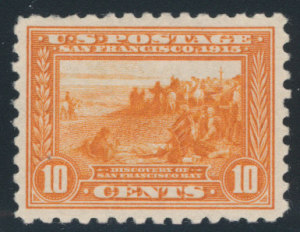Another area of catalog inconsistency concerns shades. Generally speaking, Scott lists all shades of a stamp as minor (that is "a") numbers. If a stamp is issued in rose, the major catalog listing is for rose and all of the shades of rose from dark rose to scarlet are listed as minor numbers. Only when a color is truly changed, say from red to blue, does the catalog give that stamp a different major number. This is a pretty good system as it lets general collectors concentrate on getting the major different stamps while allowing specialists to concentrate on shade varieties. In a few areas this breaks down and one of those areas is Canada #16-17. Pictured above is #16 along with a few other of the 10c shades that are listed as varieties of #17. This is a stamp that has scores of shade varieties. Indeed red lilacs tend to be among the most variety prone of all stamp shades (look at the plethora of varieties on US #70 and 78) as the ink changes a bit over time and it seems that almost every
Monthly Archives: July 2020
- Read more »
- Posted July 12, 2020in NewsRead more »
When it is found in family and friends, inconsistency can make make a person's life miserable. But when found in our hobby, it adds spice and interest. Pictured above is one of my favorite stamps because of what it tells us about our hobby and the mercurialness of the editors of the Scott catalog. It is Scott #211 of Mexico and in 2020 it catalogs $225 used. It has the design, denomination and color of the 25c catalog value stamp of the previous issue set, but the reason that it is valuable is that it has a compound perf of 12x6 (compound perfs are when the sides are perforated differently than the top and bottom. This was done for a variety of reasons, mainly in the late Nineteenth and early Twentieth Centuries, as an experiment, to find the optimal perforation type-one in which the sheets didn't fall apart in the postal clerk's drawer and which still separated easily. Needless to say, perf 12x6 was a short lived experiment. It separated too easily vertically and with too much difficulty
- Posted July 08, 2020in NewsRead more »
Philatelists want several things in an area in which they decide to specialize. They want availability. It is no fun to collect a country or sub specialty where there is little material available and the game is all search and no find. They want affordability. Unless you are Midas (and he lived in the pre-stamp period) constantly coming up against wallet bashing numbers when you find an item you need soon gets stale. And they want high production values-attractive well produced stamps by a responsible post office. Netherlands philately combines all of these factors. Their stamps are well designed and handsomely printed. The issuing policy of The Netherlands has always been conservative and as one of the major commercial and most educated nations of the world their stamps have been well used and retained by the Dutch resulting an active dealer corps with available stocks. There are few expensive rarities and the country is completable by people of even modest philatelic means. There are
- Posted July 05, 2020in NewsRead more »
The scarcest US commemorative in mint condition is the 10c orange perf 10 #404. Fewer of the higher value dollar denomination Columbian and Trans-Mississippi were issued than #404 but far more of the 10c were used on commercial mail and thus used and lost to collectors. Here's the story: For many years leading up to the issuance of #404 the Post Office had been receiving complaints about the perforations on United States postage stamps. The perforation gauge that was used was perf 12 and this was just too close resulting in many sheets of stamps separating on their own often even in the postal clerk's drawer. The simplest solution for this was to change the guage of the perforation so that there were fewer perforations per row and thus stamps would be more difficult to separate. This was tried for the first time on the Pamana-Pacific issue with the stamps being first issued in perf 12 (#397-400A) and then, as an experiment, in perf 10 (#401-404). No great fanfare was made over this experiment
- Posted July 03, 2020in NewsRead more »
Two hundred forty four years ago the thirteen American colonies declared their independence from Great Britain and began a seven year war that would result in the the founding of the United States of America. Before our Revolutionary War, Great Britain thought of her American Colonies as a whole and lumped the thirteen colonies in with the sugar islands of the West Indies and the British possessions in Canada. Our revolution resulted in profound changes of thinking on the part of Britain on the value of her Colonies and the proper steps needed to retain them. Before 1776, Britain treated her colonies in a cavalier and dictatorial manor, with little regard for local populations and what was best for each. The individualization in British colonial administration that was result of the American Revolution was one of the factors that led to the British idea of issuing separate stamps for each Colony after 1840, not just sending off GB stamps and running the Colonial Post Offices as branch offices




